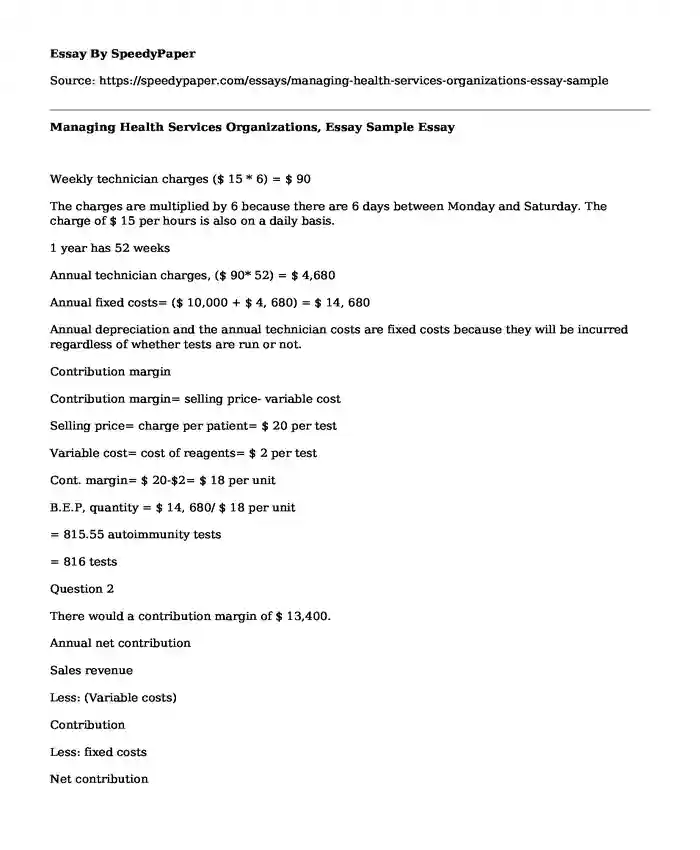
| Type of paper: | Essay |
| Categories: | Financial management |
| Pages: | 2 |
| Wordcount: | 412 words |
Weekly technician charges ($ 15 * 6) = $ 90
The charges are multiplied by 6 because there are 6 days between Monday and Saturday. The charge of $ 15 per hours is also on a daily basis.
1 year has 52 weeks
Annual technician charges, ($ 90* 52) = $ 4,680
Annual fixed costs= ($ 10,000 + $ 4, 680) = $ 14, 680
Annual depreciation and the annual technician costs are fixed costs because they will be incurred regardless of whether tests are run or not.
Contribution margin
Contribution margin= selling price- variable cost
Selling price= charge per patient= $ 20 per test
Variable cost= cost of reagents= $ 2 per test
Cont. margin= $ 20-$2= $ 18 per unit
B.E.P, quantity = $ 14, 680/ $ 18 per unit
= 815.55 autoimmunity tests
= 816 tests
Question 2
There would a contribution margin of $ 13,400.
Annual net contribution
Sales revenue
Less: (Variable costs)
Contribution
Less: fixed costs
Net contribution
Annual sales,
5 tests a day from Monday- Saturday
5*6= 30 tests a week
1 year has 52 weeks,
30* 52= 1,560 tests a year
Sales revenue
$ 20/ tests
Total sales revenue a year
$20* 1,560= $ 31,200
Variable costs
$2/ test
Total variable costs= $2 * 1,560= $ 3,120
Fixed costs
Annual depreciation $ 10,000
Annual technician charges $ 4,680
Total sales revenue $ 31,200
Less: total variable costs ($ 3,120)
Contribution $ 28,080
Less: fixed assets
Annual depreciation ($ 10,000)
Annual technician costs ($ 4, 680)
Net annual contribution $ 13,400)
Question 3
Total test per year is 1,560
We assume 1 test is equal to 1 patient
Half the total patients number will be 1,560/2= 780 patients
At break even, the profit is 0
Desired profit= 0
BEP= fixed costs in total+profitmargin contributed in unit = ($ 14, 680 + 0)/ ($20-$2)
=$14,680/ $18
=815. 55 patients
= 816 patients
The laboratory will not break even on the equipment if half of the patients have Medicare coverage (Longest, Rakich, & Darr, 2000).The number of half patients of 780 is lower than 816 which is the number of patients required to break even.
We will have to do a capital budgeting analysis of the project to see if the project is worthwhile.
Application of payback formula
Payback time = Preliminary investmentCash flow AnnuallyInitial investment is the purchase cost of the Machine which is $ 50,000.
Annual cash flows
Sales revenue- expenses
We will use the number of patients who are not under Medicare in a year of 780
Annual Sales revenue 780* $20= $ 15,600
Annual Variable expenses 780* $ 2= $ -1, 560
$ 14,040
Less: technician costs $-4, 680
Total annual cash inflows $ 9,360
Depreciation is not included in the calculation as it is a non-cash expense, no actual cash is paid.
Payback period= $ 50,000/ $ 9,360= 5.34 years
The payback period is 5.34 years.
The hospital should not acquire the machine because the initial cost of investment of $ 50,000 will be recovered after 5 years which is way past the useful life of the machine of 5 years (Longest, Rakich, & Darr, 2000).
Reference
Longest, B.B., Rakich, J.S., & Darr, K. (2000). Managing health services organizations and system. Baltimore: Health Professions Press
Cite this page
Managing Health Services Organizations, Essay Sample. (2022, Apr 28). Retrieved from https://speedypaper.com/essays/managing-health-services-organizations-essay-sample
Request Removal
If you are the original author of this essay and no longer wish to have it published on the SpeedyPaper website, please click below to request its removal:
- Essay on Advantages and Disadvantages of Technology Replacing Manual Jobs
- Free Essay Example on Theological Mentors
- Free Essay with an Application Letter to Virginia School of Dentistry
- Role of Human Resources to Managers, HRM Essay Example
- Historical events (less than 60 words):
- Essay Sample on Meniere Infection
- Essay Sample on Optimal Logistics: Planning, Transport & Storage for Businesses
Popular categories




